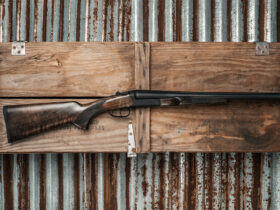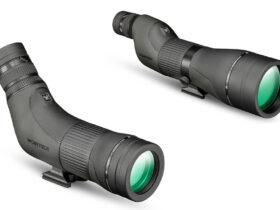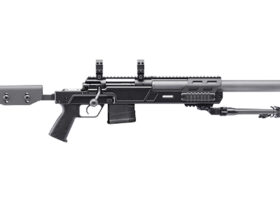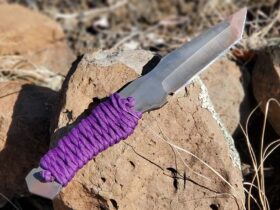Traditional long rifles and shotguns with presentation-grade wooden stocks are generally not equipped with swivel studs. To address the need to attach a carrying sling for the field, a hybrid sling can be made that hugs the stock and barrel without having to drill into the wood. The following tutorial will provide all the necessary steps to make this type of rifle sling with a cinch barrel attachment and a rear lace-up pocket. This will provide a means to carry a rifle or shotgun over the shoulder in both comfort and style. A paracord rifle sling is and option, but we’ll focus on a leather rifle sling here.
The Tools You’ll Need for Your Leather Rifle Sling
- Cutting board and utility knife
- Graph paper, cardboard, manila folders and red pen
- 3/16-inch hole punch
- ⅛-inch hole punch
- 1-inch oblong punch
- Contact cement
- Compass spacer or fork and leather stitching punch
- Leather edger
- Rawhide mallet
- 5/6-ounce leather
- Suede of choice (optional if a stitched look is desired)
- Yardstick and ruler
- Spray bottle filled with water
- Stitching needles and thread
- Fiebing’s Tan-Kote
- Chicago screws
- Optional leather lacing
After gathering all of the necessary supplies and checking to make sure your firearm is unloaded, you are ready to begin creating your traditional sling. Make sure to read through all of these steps prior to starting this project.
This traditional rifle sling is broken down into three components: The rear laced pocket, sling strap and forward cinch attachment. This leather rifle sling will be made for one firearm and will require minor fitting for an exact fit when it is used on other firearm models. It may fit other rifles as is, but not perfectly. As designed, the sling strap can also be used independently with rifles that have traditional swivels and sling-attachment points, adding to its versatility.
Forward Attachment
The forward attachment of this rifle/shotgun sling is meant to loop around the barrel, hugging it for retention. The weight of the firearm keeps it in place and eliminates the need for a forward sling swivel stud. This forward attachment is relatively easy to construct, install and may be omitted if the rifle is equipped with a forward swivel stud. Given the location of the attachment point, the rifle or shotgun will ride with the flat of the firearm receiver against the body instead of hanging from the bottom of the firearm.
Step 1:
Using the template, trace a similar design to the image shown on graph paper. Transfer this to a manila folder and place it around the barrel of the firearm to check for sizing. The fit should be snug but still allow for movement up and down the barrel with a quarter-inch of space.
Step 2:
Provided the forward attachment has the appropriate fit, transfer the template to the leather using a red pen. Make sure to cut out the oblong punch holes in the leather and transfer the placement of these as well.
Step 3:
Using a utility knife, cut out the design traced on the leather template.
Step 4:
Either use a 1-inch oblong punch or take the 3/16-inch punch and connect the holes with a ruler and red pen. Cut halfway from the end to the center and then from the other end to the center. This will prevent cutting outside the 1-inch width of the hole.
Step 5:
Clean up the edges of the forward sling attachment with an edger. This will give it a more presentable finished appearance.
Step 6:
Finish the leather with your preferred oil dye. Allow it to dry, then apply a single layer of Fiebing’s Tan-Kote.
Leather Rifle Sling Strap
The sling strap is relatively easy to create with nothing more than a utility knife, ruler, pen, punch and rawhide mallet. Finishing the strap with a suede-stitched lining and beveled edges is optional, but it does add a touch of refinement.
Step 1:
Using a piece of graph paper (two pieces can be taped if necessary) sketch out the widest portion of the shoulder strap to your desired shape. A simple symmetrical taper is shown for this project. Understand at least 6 inches at the top and 18 to 24 inches at the bottom will be used for the actual strap.
Step 2:
Cut your pattern from the graph paper and transfer it to the leather using a red pen.
Step 3:
Carefully cut your pattern out of the leather using a utility knife on a cutting board. If your hide is too short, you can cut the strap in two pieces and fold it over as shown.
Step 4:
Measure out adjustment holes, and using a rawhide mallet, punch them with your 3/16- and 1/8-inch-diameter punches for the front and backside of the Chicago screws, respectively.
Step 5:
Using an edging tool, clean up the edges of the carrying strap. If you wish to dye your leather, this would be the phase to do it to prevent bleeding through to your suede lining. Steps 6 and 7 that follow are optional. They involve stitching but don’t require advanced skills.
Step 6:
Wet the leather and pre-curve it to shape. Overlay it on top of your suede lining and trace the outline. Make sure to round the top and bottom where the carry strap is, as there won’t be an opportunity to cut it once it is glued. Apply a thin layer of contact cement to the unfinished side and overlay the suede. Allow it to dry.
Step 7:
Using a leather stitching wheel, mark your stitching holes from the finished side where the suede is layered. Punch out these holes with a squeeze punch. Stitch the entire overlaid section using a saddle stitch. The edges of the sling strap can be cleaned up with a utility knife if there is excess suede overlapping.
Laced Rear Pocket
The rear pocket will bear the weight of the firearm if carried muzzle up and requires lacing with rawhide or paracord. It is an ambidextrous design allowing for the mounting of the sling on the left- or right-hand side of the receiver. The tension of the lacing and the weight of the firearm keep the rear pocket in place.
Step 1:
Use graphing paper to sketch out the designs and overlay onto the rifle stock. The basic design will vary in shape based on the firearm buttstock it will cover. Use scissors to cut out this design once it lays over the stock in the correct location.
Step 2:
Transfer the buttstock sleeve pattern on the graph paper to the leather. Ensure the finished side is up and the rough side will be against the firearm stock. Use a red pen to mark the untreated leather, as red will not show as clearly as other colors once dyed. Do not discard the paper template.
Step 3:
Using a carpenter’s knife, carefully cut out the patterns. Make sure to hold the knife as vertically as possible while cutting out the designs to ensure clean edges.
Step 4:
Since this sling will be laced on with paracord, the next step is to punch lacing holes. The lacing holes will vary based on preference, but for this particular sling, there will be six spread out every 0.75 inches. Before punching the holes in the leather, use a pen and mark them on your paper template to ensure proper placement. After checking to see if the holes line up correctly, trace them onto the inside of your leather stock wrap with a red pen.
Use a 3/16-inch round punch and a rawhide mallet, working from the unfinished side, and punch the holes with a firm strike of the mallet. Since you already have the mallet out, use the oblong punch to create the hole where the sling strap will pass through on each side of the pocket. Leave at least a quarter-inch all around the hole to provide enough strength for the rear pouch to hold the weight of the firearm.
Step 5:
With a leather edger, bevel every side of the rear attachment on the finished side.
Step 6:
Use a 3/16-inch punch and 1-inch oblong punch on the rear strap. Finish the rear strap with the edger.
Step 7:
Use a wool dauber to apply leather dye. Allow it to dry, then finish with your choice of leather protective sealant such as Tan-Kote.
Step 8:
Run the rear strap through the oblong punched holes in the rear pocket to one side. Lace the rear pocket with leather or paracord from the narrow end to the butt end of the stock. Make sure the pocket is firmly secured against the stock.
All Together for the Leather Rifle Sling
The three components work as one to provide the user a sling that can be attached to a rifle or shotgun without swivel studs. If a more traditional look is desired, the sling strap can be adjusted and tied in place with leather lace. Otherwise, Chicago screws can be used for ease of adjustment and security. The standard setup also allows the sling to be mounted with the strap pad forward, but for African-style carry, the sling pad can be mounted toward the buttstock for muzzle-down orientation. The sling strap, minus the forward attachment and laced rear pocket, is sized to be used with 1-inch sling swivels.
This sling offers a variety of carry methods for a variety of rifles and shotguns. From traditional to modern, it can be used to comfortably and securely carry just about any firearm in the field.
Didn’t find what you were looking for?
Source link: https://www.athlonoutdoors.com/article/diy-leather-rifle-sling/ by Kevin Estela at www.athlonoutdoors.com



















